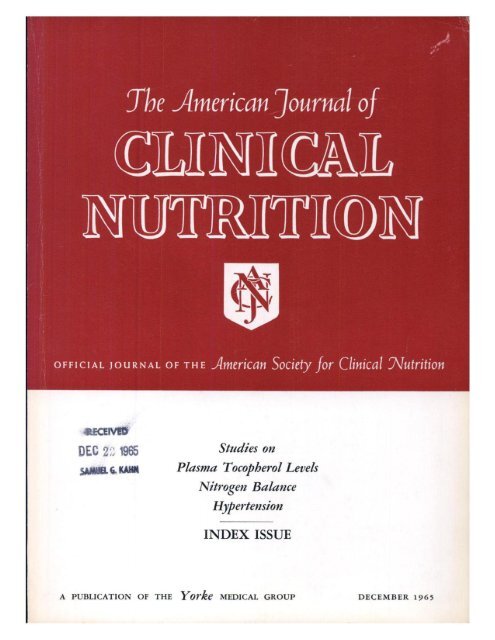Planetary Health Diet Index Trends and Associations with Dietary Greenhouse Gas Emissions, Disease Biomarkers, Obesity, and Mortality in the United States (2005–2018)
IF 6.5
1区 医学
Q1 NUTRITION & DIETETICS
引用次数: 0
Abstract
Background
Diet plays a vital role in human health and environmental effects. Monitoring diet quality and its relationship to both health and environment are essential for policy making.
Objectives
This study aimed to analyze trends in the Planetary Health Diet Index (PHDI) and its associations with daily greenhouse gas (GHG) emissions from food, disease-related biomarkers, anthropometric measurements, obesity, and all-cause mortality in the United States population.
Methods
We analyzed 27,181 adults in the National Health and Nutrition Examination Survey (NHANES) from 2005 to 2018, except for the mortality analysis. 23,599 adults were analyzed as the 2017–2018 NHANES dietary data were removed due to the potential for reverse causation. We calculated PHDI scores by using 2 24-h dietary recalls and GHG by linking the consumption of individual foods to dataFRIENDS, a food-environmental impact database. To assess associations with the PHDI, we used generalized linear regression models for GHG, disease-related biomarkers, and obesity and used the Cox proportional hazards model for all-cause mortality.
Results
The energy-adjusted mean of the PHDI (140 possible points) increased from 68.6 in 2005–2006 to 71.7 in 2017–2018 (P-trend < 0.001). Compared with the lowest quintile (Q1), the highest PHDI quintile (Q5) was associated with 25% lower GHG emissions, a better cardiometabolic profile, lower prevalence ratios of obesity [0.59; 95% confidence interval (CI): 0.50, 0.69] and abdominal obesity (0.74; 95% CI: 0.66, 0.82), and a lower risk of all-cause death [hazard ratio (HR): 0.65; 95% CI: 0.54, 0.78].
Conclusions
These results underscore the potential health and GHG emission benefits aligned with the planetary health diet.
全球健康饮食指数趋势及其与美国饮食温室气体排放、疾病生物标志物、肥胖和死亡率的关系(2005-2018)。
背景:饮食在人类健康和环境影响中起着至关重要的作用。监测饮食质量及其与健康和环境的关系对制定政策至关重要。目的:本研究旨在分析地球健康饮食指数(PHDI)的趋势及其与美国人口每日食物温室气体排放(GHG)、疾病相关生物标志物、人体测量、肥胖和全因死亡率的关系。方法:除死亡率分析外,我们分析了2005年至2018年国家健康与营养调查(NHANES)中的27181名成年人。由于可能存在反向因果关系,研究人员删除了2017-2018年NHANES饮食数据,对23,599名成年人进行了分析。我们通过使用两次24小时饮食召回和通过将单个食物的消费与dataffriends(一个食品-环境影响数据库)联系起来计算PHDI分数。为了评估与PHDI的相关性,我们对温室气体、疾病相关生物标志物和肥胖使用了广义线性回归模型,并对全因死亡率使用了Cox比例风险模型。结果:能量调整后的PHDI平均值(140可能点)从2005-2006年的68.6上升到2017-2018年的71.7 (p < 0.001)。与最低五分位数(Q1)相比,最高PHDI五分位数(Q5)与降低25%的温室气体排放量、更好的心脏代谢谱、较低的肥胖患病率(0.59,95% CI: 0.50-0.69)和腹部肥胖患病率(0.74,95% CI: 0.66-0.82)以及较低的全因死亡风险(HR: 0.65, 95% CI: 0.54-0.78)相关。结论:这些结果强调了与地球健康饮食相一致的潜在健康和温室气体排放益处。
本文章由计算机程序翻译,如有差异,请以英文原文为准。
求助全文
约1分钟内获得全文
求助全文
来源期刊
CiteScore
12.40
自引率
4.20%
发文量
332
审稿时长
38 days
期刊介绍:
American Journal of Clinical Nutrition is recognized as the most highly rated peer-reviewed, primary research journal in nutrition and dietetics.It focuses on publishing the latest research on various topics in nutrition, including but not limited to obesity, vitamins and minerals, nutrition and disease, and energy metabolism.
Purpose:
The purpose of AJCN is to:
Publish original research studies relevant to human and clinical nutrition.
Consider well-controlled clinical studies describing scientific mechanisms, efficacy, and safety of dietary interventions in the context of disease prevention or health benefits.
Encourage public health and epidemiologic studies relevant to human nutrition.
Promote innovative investigations of nutritional questions employing epigenetic, genomic, proteomic, and metabolomic approaches.
Include solicited editorials, book reviews, solicited or unsolicited review articles, invited controversy position papers, and letters to the Editor related to prior AJCN articles.
Peer Review Process:
All submitted material with scientific content undergoes peer review by the Editors or their designees before acceptance for publication.

 求助内容:
求助内容: 应助结果提醒方式:
应助结果提醒方式:


